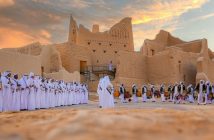In this concluding part of his odyssey in Acre, Harry Chapman drives into the hills to meet Israel’s minority groups, the Bedouin and the Druze, and encounters that emblematic rite of passage, the kibbutz…
The majority of the population in Israel is Jewish – about 70% – and most of the remaining is Arab, mainly Muslim but some Christian. But there are two further religious minority groups that are racially and religiously distinct – the Bedouin and the Druze. Admittedly most Bedouin are Arab (there are also non-Arab Bedouin) and admittedly they are a group that is scattered throughout the Middle East and North Africa, but traditionally, as desert dwelling nomads, their culture and way of life is so different to that of the Arab urbanite or agrarian, as to make them quite distinct as peoples.
It was to meet and talk with one such Bedouin family that we went one afternoon, driving high up into the hills, twisting and turning on narrow defiles, my stomach tightening as above us the storm clouds gathered to obliterate the sun. It was rocky terrain, coloured red and yellow, with tough vegetation springing forth from cracks in the ground.
Our family lived at the top. They no longer herded but had settled in a village. The house we drew up outside was big and rambling. Like its neighbours it was cheerfully scruffy. Drifts of detritus littered the pot- holed street. It reminded me of the rural villages I had visited in the West Bank six years before.

We were met at the door by our host who led us into the living room and gave us strong, sweet tea in glasses. A fire burned in the grate. It was cold outside. He soon proved himself a jovial raconteur, his round face and eyes delighting in the telling of tales, giving many things a cheerfully comic turn. The village had been established about a hundred years ago by exiled families from different Bedouin groups, from as far away as Egypt and Lebanon. He didn’t give the reasons for this exodus but it was unusual that the separate families joined forces in this manner because traditionally the Bedouin are fiercely tribal.
What he did do, with considerable astuteness, was to explain the origins of several of the more notable customs. Hospitality – of the obligation to look after a stranger for four days and to pack him off at the end with as much food and water as he could carry away – survival. Because the desert where they hail is a harsh and unforgiving place and great hospitality is a way of ensuring one’s own survival if one is ever in need of it oneself. Revenge – of the custom of taking a life of the family of those who killed one of your own, within a forty year period – again survival. Because in an environment where there is no rule of law, this primitive one actually ensures peace. No one would want a death sentence hanging over the lives of their family for four decades and so the killing of another would never be done lightly. Explained like this, it made sense to my narrow Western world view.
Even though the population of fifteen hundred in the village are mainly descended from the four original families, the times, they are a-changing. His father grew up in a tent, he in a house. And a house with all the mod cons we take for granted – electricity, running water, television, the internet. It was clear his children’s generation would take the evolution of his people much further than his did. They are being educated, one daughter even studying medicine in Bulgaria.
Our host smiled. “This is how all Bedouin used to look.” He held up a gnarled finger in the flickering firelight. “He walked twenty kilometres over the rocks of the mountains every day, following the goats. And now…?” He looked down at his paunch. “If a person comes to the village saying he is looking for the man with the big tummy, three hundred men will come out. Now the Bedouin goes to the gym, runs for twenty minutes on the treadmill, then puts all the weight back on with a big meal!”

One thing hasn’t changed. Yet. Most Bedouin there still kept animals – in his case goats and chickens. He claimed he still rose at the sound of the old alarm clock – the cockerel’s cry – and this was important to his soul.
If the Bedouin community is of the earth, of hard practical things, then the Druze community is of the air, of esotericism and secret matters. We also visited a Druze family but I didn’t quite get to the bottom of who they were as I felt I had with the Bedouin.
“We know things,” our host’s wife intoned mysteriously. “We have secrets.” Although I took this as a tease, it became evident that she was not joking. The Druze community is divided into two groups – the al-Junnal or the Ignorant, which comprises about 80% of the population, and the al Uqqual – the Knowledgeable – who form the remaining 20%. It is only the latter who are able to view the holy texts and attend religious meetings.
It put me in mind of the Masons but is not a society but a recognised religion, created in Egypt in the 10th and 11th centuries as an of-shoot of Islam but combining elements of Hindu and Greek philosophy. In fact the Druze do not allow conversions as they believe that all living Druze are reincarnated from that first generation. Our host’s wife, dark and hollow eyed, swore that she could remember her last two lives and that her children from these two identities were still alive. Although a monotheistic religion, the Druze do not hold with the personality cult of the divine but believe that God is all around, as much within as without.

The wife’s vocal-ness reflected the Druze belief that women are equal to men (although she was still very much in charge in the kitchen.) Our host was a very different proposition to our Bedouin friend. A short, handsome man of about fifty, he possessed an educated cleverness and was clearly well integrated into Israeli Jewish society. It is an interesting feature of the Druze that they are the only non-Jewish minority drafted into the military and many have attained high rank in both the armed forces and in politics. Indeed our host himself had served in the army for twenty five years and had risen to the rank of colonel.
This gave him a rather unique position as part of the Establishment and separate from it at the same time, and he spoke with some insight. It was his view that the Jews – and they were mainly educated European Jews – had been granted Israel so that the West would have a strong ally in the Middle East, especially when it came to oil. The Druze are generally considered to be ethnically Arab, but our friend had a rather politically incorrect view of others of his race; “The Jews plan for two years, five years. The Arab just wonders what he is going to eat in the morning.”
To give a sense of traditional Israeli Jewish custom we were taken along to visit a kibbutz. Indeed our trip would not have been complete without a visit to one of those venerable but anachronistic institutions. Along with the Hippie Trail that led the Flower People and assorted seekers of wisdom to the then peaceful kingdom of Afghanistan in the sixties and seventies, every other dauber or balladeer seemed to fetch up in a kibbutz during the same period. As late as the eighties I remember a friend from school spending a year on one helping to inseminate turkeys in what sounded a rather violent exercise. But by then the kibbutz as an idea and a reality was withering.

The kibbutz started at the turn of the last century by Jewish refugees from the Russian pogroms. They were essentially agricultural communes, combining principles of socialism and Zionism. With the Balfour Agreement and the British Mandate after the First World War, the creation of a Jewish state seemed like a very plausible reality and the kibbutzim multiplied. So too, perhaps inevitably, did the conflicts with the indigenous Arabs.
Our kibbutz, set in the hill country in the very north of the country, a stone’s throw from the Lebanese border, was built during this time in the 1930s, ten years before the creation of the State of Israel and when relations between Jews and their Arab neighbours had reached a violent peak. It was established in what was called the “tower and stockade” method. Men moved into the area in the middle of the night with materials for a wooden watch tower and stockade. They were armed and with them were a group of militias. They threw up the fortifications.

On the first night they were attacked by Arabs but repelled them, losing two men. Over the following month skirmishes would claim eight more but eventually the camp was established, women moved in, children were born, crops raised. It was extraordinary to think of this happening in the twentieth century, on what are very nearly the borders of Europe. It was like something out of the Wild West. The Normans used similar tactics of offence/defence in securing Anglo Saxon England with their motte and bailey castles.
The gentleman that showed us round, shuffling and speaking in a whisper, was a child of that first generation and he had never lived anywhere else. The kibbutz was past its heyday, was scruffy and a trifle listless although I understand there has been a renaissance in the fortunes of many kibbutzim with some even branching into high tech and military industries. But privatisation is now common with many kibbutzniks buying their homes and even working off site. The notion of the pure agricultural collective is now a thing of the past.
On the way back to the airport we stopped off to see the old Roman aqueduct at Caesarea. The town was built by Herod the Great and served as the capital of Judea province during the Roman occupation. Pontius Pilate was one of the governors who acted here. It was once so populous that three aqueducts were built to water its citizenry. The place, like many towns of antiquity, now lies in ruins.

The section of aqueduct we visited lay a few miles north of the old city and ran along the beach, parallel to the water. It was a strange thing to see it there. The day had started warm and I had to remove my jacket. It was classic Mediterranean weather – the sea glittered broad and blue, the yellow of the sand stretching down to greet it and then this vast thing, monolithic, bisecting the two, looking as though it had been deposited there by the hand of a giant. It was both incongruous and congruous, the yellow of the stone crumbling to join the yellow of the sand. Its passage was halted where I stood, the structure obliterated as if hit by a bomb, but the rest of it continued up the coast in a long line of graceful arches in faced blocks supporting a high channel of smaller stones, all the way to Mount Carmel where the springs used to feed it. It was a beautiful ruin. The Romans certainly knew how to build. It put me in mind of Shelley’s poem, Ozymandias; “…Round the decay / Of that colossal wreck boundless and bare / The lone and level sands stretch far way.”
It was a fitting end to the trip and reminded me of how many had fought over that piece of land on the eastern seaboard and how in most cases just a few broken remains survive their passing. It is perhaps absurd to think that land belongs to any of us. We are, at best, its temporary custodians.
For more information about Akko and its surrounding area, including places to visit, things to do, events and planning your trip, visit www.new.goisrael.com.




